Awesome YA Books Published this Fall
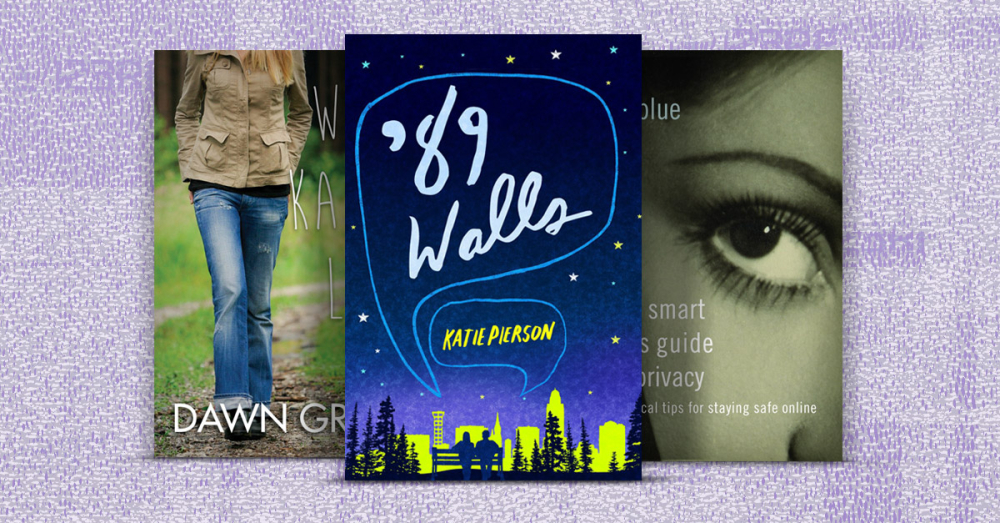
Teens are some of the most voracious readers out there. The book world has recognized that and publishers are now cranking out YA books with an intense velocity. But the young adult genre can also come with some misconceptions: it’s “easy reading” and chock full of romance. But indie books defy the formula that many YA books seem to follow. They’re out there, and they’re awesome! For teens who are looking for genre-specific books but want protagonists their age, there is something here for everyone. These YA fiction and nonfiction selections come from our Fall 2015 issue. From a frank look at teen life in the past to solving a murder, you’re sure to find a book you want to read. Or two. Or five.
YA Fiction
’89 Walls
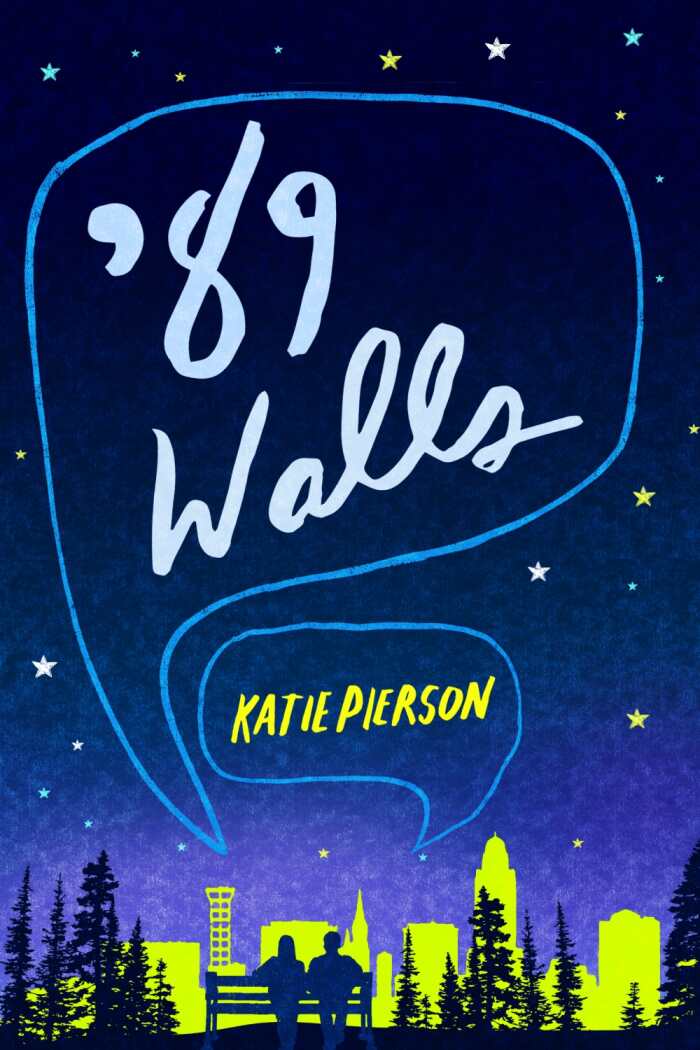
Katie Pierson
Wise Ink Creative Publishing
Softcover $13.95 (264pp)
978-1-940014-55-5
Buy: Amazon
This mature novel for young adults explores growing up and developing political opinions, even while bringing the decade of boom boxes and big hair to life.
The 1980s was a unique decade in American social and political history, and Katie Pierson does a stunning job of weaving much of it together for young adults in ’89 Walls. There is enough pop culture, music, fashion, and teen angst to make it a fun read, yet Pierson doesn’t water down her political debate or the bittersweet undertones of her story.
Seth and Quinn are typical star-crossed lovers. Pierson builds on this familiar framework with the story of the young girl born into a privileged conservative family living in the nicest neighborhood and the boy from the other side of town raised by a more liberal single mom with MS. Once their unlikely love is discovered, they tangle with the expected challenges—passing judgment on each other’s friends and hurting each other’s feelings with the typical “I’m sorry my blue-collar future isn’t good enough for you.”
The two young lovers are very different from each other, but Pierson doesn’t depend on this formula to carry out her agenda. Her characters are acutely aware of what’s happening in the world around them. They try out their own political opinions in conversations with their parents. When Quinn is in real trouble, she reaches out to them.
Every bead of sweat and exhale of breath brings a tantalizing physical passion between Seth and Quinn to life, but things get real when she approaches her mom about getting an abortion. Quinn appears uncommitted to how she should feel about her decision, which does little justice to the reader by making sex so palatable and exciting and abortion no worse than “I napped for a day. That was it.” Besides shying away from the opportunity to connect on some of the larger issues, Pierson still opens the door for independent thinking and adult responsibility.
’89 Walls is a firestorm of hot topics from Apartheid and Tiananmen Square to college applications and lost innocence. With a thoughtful glossary, further reading list, and complete bibliography, Pierson invites young readers to disagree, to learn more, and to make sure that they understand what they believe.
SARA BUDZIK (August 17, 2015)
The Boy Meets Girl Massacre
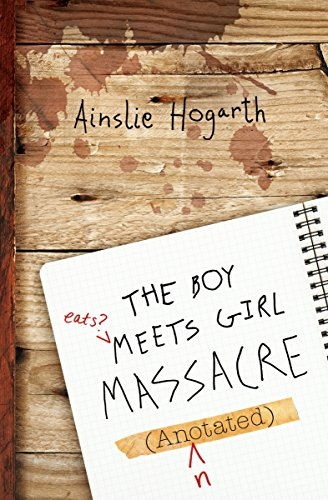
Ainslie Hogarth
Flux Books
Softcover $11.99 (288pp)
978-0-7387-4472-8
Buy: Amazon
This grisly and bizarre murder mystery is the perfect YA stepping stone to Stephen King.
A washed-up detective contacts a movie producer for a meeting. He asks for money and presents the producer not with a script, but with the diary of Noelle Dixon, a teenager killed by a pickax to the head. Eight other bodies, all dead by pickax, smear against the floor of various parts of the same hotel in which Noelle was found. Improbably, this dead girl is the primary suspect in this unsolved case. The producer, thrilled with the bizarreness of the encounter, takes the diary, reads it, and adds his own annotations to those of the detective. This strange, incredibly grisly story will likely thrill teenagers and horrify their parents.
Sixteen-year-old Noelle decides to work at the Boy Meets Girl Hotel, the scene of a cannibalistic murder. In order to try to shake off the gloomy atmosphere of the place, Noelle writes down her thoughts in a diary, but the diary becomes terrifying in and of itself as long stretches appear in a hand that is not quite Noelle’s, but not quite someone else’s. These instances chronicle animal abuse and a host of other bizarre happenings and thoughts.
As a character, Noelle comes from a rough place. She must handle a father who is sick, demanding, lonely, and pathetic—all of his illness is located in the bowels, making him physically repulsive in addition to being endlessly needy. Noelle’s friend Alf works with her and has a shy crush on her. Noelle comes to life in the diary with vivid writing and a kind of teenage thought process rife with swearing and ranting. She also has a terrible habit of picking at an increasingly raw spot on her head until it achieves the consistency of salsa.
The book relies on a great deal of grisly description in creating its horror, whether it is a pickax to the head or the blinding of a small cat. This is definitely not for the weak stomached. For teens not quite ready for Stephen King, this book makes a nice stepping stone.
CAMILLE-YVETTE WELSCH (August 27, 2015)
The Charity Chip
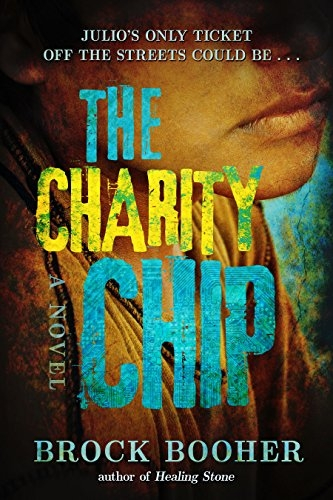
Brock Booher
Sweetwater Books
Softcover $16.99 (288pp)
978-1-4621-1669-0
Buy: Local Bookstore (Bookshop), Amazon
Poverty, the true costs of charity, and the value of life are all themes compellingly explored in this novel based in Lima.
Fourteen-year-old Julio has found it harder and harder to provide for himself and his twin brother since the advent of implanted money chips a few years ago. People no longer have spare change to give to an orphan juggling fire batons at the traffic light, so the opportunity to be implanted with a chip as part of a charity program seems like a dream come true. In his provocative novel, The Charity Chip, Brock Booher explores themes of poverty, charity, and the value of one life over another in a story layered with suspense, drama, and action.
One of the toughest issues faced by aid organizations is actually getting the money they raise into the hands of the people they want to help. The money chip, a device implanted into one’s hand, appears to be the perfect solution to cutting out the middle man. Isak Blixt, a smooth and confident foreigner, forms a charity that allows children in his program to receive the food, clothing, and education they need while maintaining their independence. What Julio isn’t sure of is what hidden price there may be to accepting Isak’s charity.
Booher, the author of Healing Stone, builds his second novel on an interesting and thought-provoking premise: what happens to people in poverty when the world switches almost exclusively to electronic forms of money transfer? Is it possible to have charity without corruption? He clearly depicts what it’s like for kids to live on the margins in Lima, Peru, quickly building a detailed world ruled by the need to survive with a desperate lack of resources. The smell of roasting chickens combined with the sizzle of fat dripping into the open fire makes Julio’s stomach growl, and the cheers from the stadium where the popular Alianza Lima plays soccer bring back memories of better days with his father. Strong descriptive prose coupled with the intriguing story of a mysterious foreign charity, which may or may not be what it seems, makes for a fast-paced book that will appeal to many readers from middle schoolers to adults.
CHRISTINE CANFIELD (August 27, 2015)
The Girl Who Ignored Ghosts
The Unbelievables Book 1
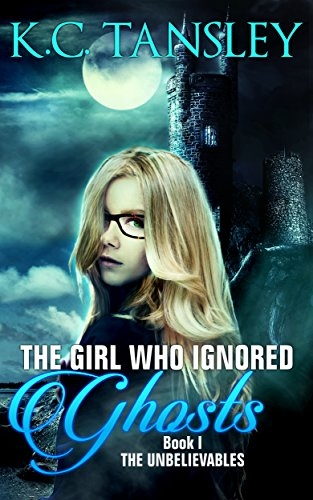
K. C. Tansley
Beckett Publishing Group
Softcover $12.99 (243pp)
978-1-943024-00-1
Buy: Local Bookstore (Bookshop), Amazon
Those who enjoy suspense, ghost stories, and a little hint of romance are sure to devour Tansley’s novel and its eventual sequels.
Supernatural and romantic elements are woven together nicely in K. C. Tansley’s first book in the Unbelievables series, The Girl Who Ignored Ghosts. Though geared towards young adults, people decades older are sure to enjoy the palpable suspense woven throughout the novel.
Kat Preston is a teenage prep-school student who, for as long as she can remember, has had the ability to communicate with ghosts. Most of them just want the living to help them resolve conflicts they had when they were alive, but some want much more. After a short possession by one of these ghosts, Kat swears to do the thing that most drives them off: not believe in them. This succeeds just fine until she is called to help her professor with a huge research project on the Isle of Acacia, the site of a long-ago mystery still left unsolved. It’s up to Kat and her team to find out what really happened on Sebastian Radcliffe and Cassie Mallory’s wedding night in 1886, when the couple disappeared from their room, which was left covered in blood. A curse also began that night that will take the life of every succeeding Radcliffe heir, and it’s about to kill the latest one—unless Kat can find a way to stop it.
Tansley takes those who are willing to suspend their disbelief on a fairly enjoyable ride. Kat Preston is easy to care about and seems relatable—except for the whole seeing-ghosts thing. The central plot of The Girl Who Ignored Ghosts is time travel for Kat and Evan, a fellow team member. Aside from the fairly strange way Tansley makes that happen, reading about the two teens inhabiting the bodies of those central to the Sebastian/Cassie mystery is riveting. Some of the characters can be tricky to keep straight, but it’s interesting how the ones of modern day end up connected to those of old.
It’s obvious from the last pages that there will be many more adventures for Kat and her team.
KELLY THUNSTROM (August 27, 2015)
When Kacey Left
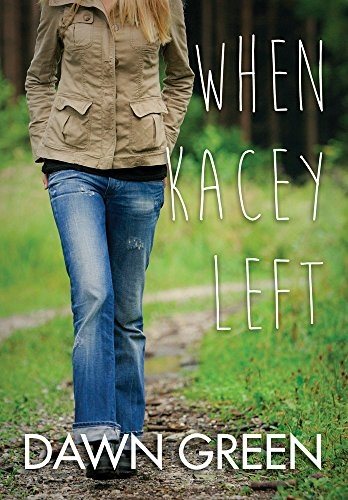
Dawn Green
Red Deer Press
Softcover $12.95 (228pp)
978-0-88995-523-3
Buy: Local Bookstore (Bookshop), Amazon
The journal format of this spare novel allows for an in-depth examination of the daily grief experienced after a friend’s suicide.
When Kacey Left, an epistolary novel, traces the aftermath of teen suicide. Dawn Green’s succinct story for high schoolers examines bewilderment, and displays a talent for portraying the unsettling feeling of being defined as the best friend of the girl who died. Through a series of letters that imagine conversations between the writer, Sara Stickley, and Kacey, and letters that detail Sara’s return to school in the midst of curiosity and sympathy, living with absence turns both emotional and revelatory.
Sara’s letters to Kacey begin as a therapeutic exercise suggested by her counselor. At first reluctant to participate in what she views as a “punishment,” Sara gradually opens up to confronting pain. The choice to frame the novel as a journal allows for raw informality. Memories, text messages, Sara’s take on events at school, anger, and longing all have a place, creating a realistic, fragmented journey that sometimes leaves Sara reeling and other times leaves her tentative, with questions such as “Does moving on with my life mean forgetting yours?” The approach is poignant, though by necessity, it leaves minimal room for developing secondary characters and setting (as Sara would likely omit such details, knowing that her addressee was familiar with them). Despite the layer of remove the journal creates—even as it simultaneously invites a sense of witnessing deeply personal grief—it’s an effective way to show how daily pressures build.
Green wisely allows other perspectives to enter as Sara expresses frustration. The views administrators, teachers, and parents take emerge as a mixture of downplaying “the situation” and of watching Sara closely, in fear that she, too, may show signs of depression. Without seeming didactic, the novel ably depicts some of the realities of suicide, the most rending of which may be the fact that there is never an adequate explanation for why.
Intense in its accumulation of gestures, words, and impressions, When Kacey Left allows the subject of suicide to become not an event but the beginning of a larger conversation.
KAREN RIGBY (August 27, 2015)
YA Nonfiction
Lots of teens use books to leave their world and enter another. Books are amazing—you can do anything in a book, from fight a dragon to fall in love. But sometimes, life gets too hard to ignore. When escaping into a book just doesn’t cut it, it’s time to seek some advice… from a book. Here’s some self help to get you through the tough teen years.
Be Audacious
Inspiring Your Legacy and Living a Life That Matters
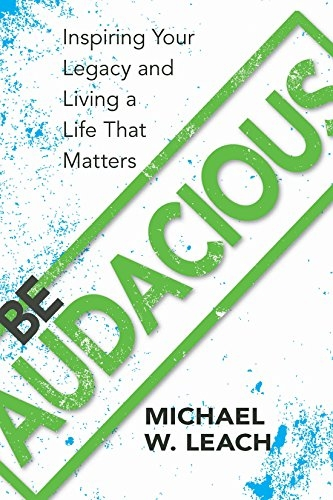
Michael Leach
WestWinds Press
Softcover $18.99 (278pp)
978-1-941821-72-5
Buy: Amazon
Practical exercise, mantras, compelling anecdotes, and stories of scrappiness all help instill an audacious kind of confidence in kids.
Be Audacious features stories of grit and scrappiness that are required for overcoming adversity; the vulnerability needed at the heart of authentic leadership; purposeful, sustainable passion as keys that unlock potential; and the planning needed for big dreams.
At 35, author Michael Leach inspires youth and millennials, living his life as testament to and training ground for the book’s “be audacious” message. He shapes a captivating tale, supported by practical exercises, mantras, and compelling anecdotes. His personal growth lessons resonate as an embodiment of the Be Audacious movement, philosophy, and way of life—to “inspire people to pursue their passion, live a life that matters, and change the world.”
Being diagnosed at 19 with ankylosing spondylitis (AS), a chronic autoimmune disorder, served to shatter his dream on the basketball court. Later, Leach recounts coaching his basketball team from a wheelchair after surgery, leading to a cultural healing during playoffs with a reservation team. “I don’t share the stories … to wow you or to boost my ego; I simply wish to remind you of what is possible when we remain resilient.”
In his words, “The simple but powerful tools and stories that unfold here—if adopted and embraced—can become a foundation upon which you face and ultimately embrace what the world throws your way.” Leach shows what that looks like as each adversity calls forth every ounce of resiliency. He also redefines “swagger,” including a host of variations, reframing its negative baggage. “I’m talking about humble swagger, authentic swagger—what I like to call swaggage. I love these terms, as I’ve seen them work with young adults, inspiring a more contemporary and audacious kind of confidence.”
Authentic leadership frames the bigger picture. He says, “Twenty-first century leadership is about positively impacting the world around you by doing it your way. … Whatever fuels your heart, identify it, nurture it, and lead with it!” Each chapter’s practice exercises help the insights sink in. Leach concludes with “Your Legacy—A Life that Matters.” He shines the Be Audacious message like a beacon in his fresh, unexpected voice.
BOBBYE MIDDENDORF (August 27, 2015)
The Smart Girl’s Guide to Privacy
Practical Tips for Staying Safe Online
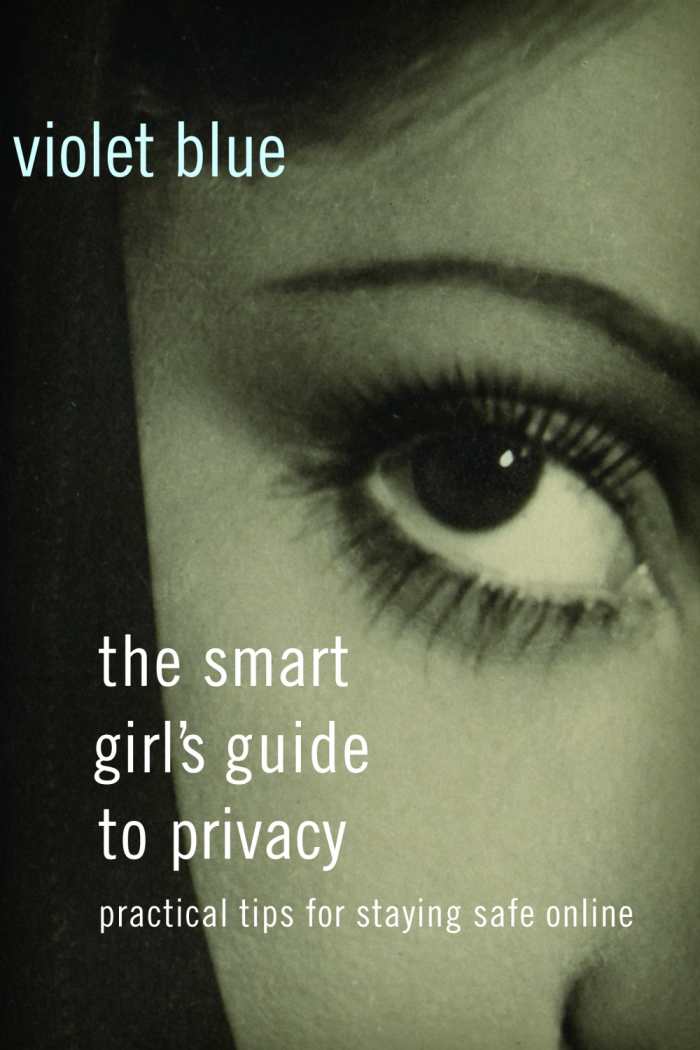
Violet Blue
No Starch Press
Softcover $17.95 (176pp)
978-1-59327-648-5
Buy: Local Bookstore (Bookshop), Amazon
For girls and women in the technological age, this guide to Internet safety is a must-read.
The Smart Girl’s Guide to Privacy should be given to every teenage girl with an Internet connection. “The sad fact is that women have more reasons to be concerned about online privacy than men do,” investigative tech reporter Violet Blue writes, “because women are at a greater risk for physical violence and are directly targeted more often than men.”
Blue proves that the dangers are very real. A hacker secretly turned on the web cam of a Miss Teen USA’s computer and tried to blackmail her with nude photos. A Sprint employee was caught sharing intimate photos he’d nabbed from a female customer’s old phone. A California teen killed herself after she was raped and the video was passed around at school.
Furthermore, online privacy is not just about sex. Blue outlines corporate-sharing schemes that allow advertisers to compile dossiers on users’ likes, dislikes, and online habits. “Your information is sold to advertisers for about two-fifths of a cent per bundle as part of an enormous, multibillion-dollar industry that centers on the collection and sale of you,” Blue writes. “You are the product. And business is booming.” Blue also writes of a male Wired journalist who endured a cyber attack in which all his information on his smart phone, tablet, and laptop were erased, including photos of deceased family members and the first year of his baby’s life.
Her scare tactics are backed up by critical methods on how to check whether your online world has been compromised as well as color-coded lists of the types of information you should never share, sometimes share, and are okay to share. She walks users through setting the right privacy filters on social media, how to have the strongest passwords, and the legal steps necessary to fight an online bully.
The Smart Girl’s Guide to Privacy is not written for parents trying to micromanage their kids’ online life. It’s a young woman’s invaluable guide to empowerment, addressing not only the why of keeping strong boundaries but the how.
AMANDA MCCORQUODALE (August 27, 2015)

Hannah Hohman is an editorial assistant at Foreword Reviews. You can contact her at hannah@forewordreviews.com.
Hannah Hohman
